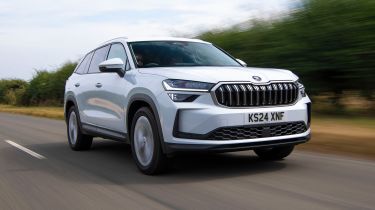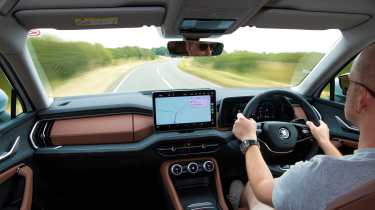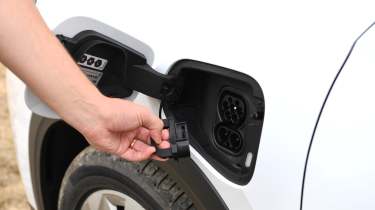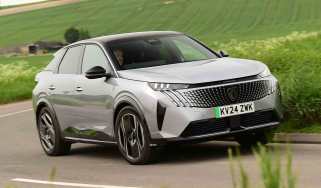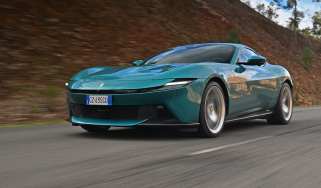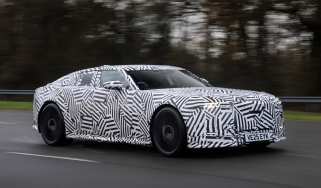Skoda Kodiaq iV review: class-leading large SUV gets plug-in hybrid power
Skoda has finally brought plug-in hybrid power to the Kodiaq, but this comes at the cost of practicality

Verdict
Of the many plug-in hybrid cars available right now, the Skoda Kodiaq iV’s brilliant electric-only range means it makes more sense than most. However, in sacrificing the third row of seats, the car loses some of its flexibility, and the battery will be expensive to charge unless you can do so at home. So while it’s part of an excellent Kodiaq line-up and will be the choice of company car users thanks to tiny Benefit-in-Kind costs, this model makes the least sense for private buyers.
In many ways, the new Skoda Kodiaq has already proven itself to be one of the smartest SUVs around. Look beyond the umbrella slotted neatly into the driver’s door, a virtual tailgate and even a little cleaning bottle that doubles as a wipe for the new 13-inch touchscreen infotainment system, and in the shape of the new Kodiaq iV, it’s gained some trickery under the bonnet, too.
That comes in the form of what Skoda and the wider Volkswagen Group calls the second generation of plug-in hybrid technology. Earlier systems were fitted to the pre-facelift Octavia and previous-generation Superb, but never made it as far as the last Kodiaq. This time around, big upgrades have been made to both the combustion and the electrical sides - and in particular the battery.
Used - available now

2024 Skoda
Kodiaq
26,068 milesAutomaticPetrol1.5L
Cash £27,245
2024 Skoda
Kodiaq
30,718 milesAutomaticPetrol1.5L
Cash £25,616
2024 Skoda
Kodiaq
28,102 milesAutomaticPetrol1.5L
Cash £26,583
2021 Skoda
Kodiaq
50,399 milesAutomaticDiesel2.0L
Cash £20,055There are plenty of PHEVs that have a token-sized EV range that can’t really offer enough to offset the weight and complexity of the electric powertrain. Not so the Kodiaq; here, it only really needs to call upon the 1.5-litre turbocharged petrol engine in exceptional circumstances because the new battery, which is located under the rear seats, offers a capacity of 25.7kWh - 19.7kWh of which is usable.
In official WLTP tests, that’s enough for 71 miles of electric driving on its own - something that proved to be very achievable in the real world. On a 78-mile journey, of which 60 miles or so were on motorways or dual carriageways, we managed to complete the entire trip, apart from one burst of acceleration, in EV mode. In more stop/start use, that range dropped lower - and the same will be true in colder months of the year when the battery isn’t able to do its best work - but it’s still an impressive feat nonetheless.
Plus, unlike some other plug-in hybrids, there’s actually plenty of performance to exploit in EV mode. The electric motor produces a modest 114bhp, but more significantly it makes 330Nm of instant torque. In other words, the performance feels absolutely fine for everyday driving.
When a little more urgency is needed, it’s possible to call upon the petrol engine. That shove comes from a 1.5-litre turbocharged petrol engine, and while the combustion and electric elements of the powertrain never produce their maximum outputs at the same time, the result of the two working together is a combined total output of 201bhp and 350Nm. But this is a car that weighs roughly two tonnes, and it seems to struggle to hit the claimed 8.4-second 0-62mph time, mainly because the engine isn’t the most responsive to wake up, and when it does, it can sound a little strained.
It’s best, then, to take things a little easier in this PHEV, something that the chassis is more than happy with. Overall ride comfort is soft and relaxing, and even though that does translate into a little body roll through the corners, and sideways, almost floaty movements over more uneven roads, the Kodiaq is still less ponderous through the turns than some large SUV rivals. Our only small gripe is that, like the new Superb, there’s a very slight fidget to the ride over smaller bumps.
While a lot of this sounds promising, the PHEV system comes with a catch. In order to package the battery, the motor and all of the other electrical systems, something had to give, and that’s the third row of seats. So if you need the flexibility of seven seats in your Kodiaq, then it’s petrol or diesel only - which is significant because rivals such as the new Hyundai Santa Fe can pair its PHEV tech (admittedly with a less impressive EV range) with space for a driver and six passengers.
If losing those seats isn’t a major concern, then this five-seat Kodiaq benefits from a gigantic boot. Officially, there’s 910 litres to play with, and while the load area is quite high, the boot floor is almost perfectly square. As with any other Kodiaq, the front five seats are hugely spacious, too. The second row is on rails, and even when it slides into its furthest forward position, knee room is still roughly equivalent to that in a Volkswagen Golf. Put it all the way back, and the space is almost limo-like.
The front two occupants are well catered for, too. The new dashboard arrangement is largely similar to that of the latest Superb, which means there’s an intuitive 13-inch touchscreen display, neat physical controls on the steering wheel, and most importantly, Skoda’s ‘Smart Dials.’ This trio of physical climate controls are easy to use, and each has a secondary function (or four, in the case of the central dial), including adjusting the seat heaters, the audio volume and the drive modes.
The standard of finish inside is great, and with the ‘Cognac’ leather of our test car, it feels really quite luxurious. Storage is excellent too, with the first-generation’s double-glovebox arrangement carried over, and this version benefits from a pair of wireless smartphone chargers in the centre console.
Unlike many PHEVs, the Kodiaq can be plugged into a rapid charger thanks to its CCS port. It’ll top up at a reasonable 50kW, which we achieved on a public charger. However, at that particular station’s 79p per kilowatt hour rate, it added 45 miles of range for £8; at current petrol prices that’s the equivalent of refuelling a petrol car that’s managing only 35.6mpg. In other words, PHEVs only begin to make financial sense if owners can charge them at home on cheap electricity tariffs.
That electric-only range is a huge draw for company car users, though. The Kodiaq iV sits in the five per cent Benefit-in-Kind bracket, so even drivers subject to the higher income tax rate will be paying just £892 per year - a full £4,844 less than the 148bhp diesel model costs.
Prices for the PHEV start from £41,935 for SE trim, which is the one we’d go for because it’s so well equipped. The SE L costs £2,700 more but adds leather upholstery, an electrically adjustable driver’s seat, matrix LED headlights, 19-inch wheels in place of 18-inch wheels and keyless entry.
| Model: | Skoda Kodiaq iV SE L |
| Price from: | £41,935 |
| Price as tested: | £44,635 |
| Powertrain: | 1.5-litre 4cyl/19.7kWh battery |
| Power/torque: | 201bhp/350Nm |
| Transmission: | Six-speed automatic, front-wheel drive |
| 0-62mph: | 8.4 seconds |
| Top speed: | 130mph |
| Economy/CO2: | 578.4mpg/11g/km |
| EV range: | 71 miles |
| Size (L/W/H): | 4,758/1,864/1,679mm |
| On sale: | Now |

